#the plot feels like a first draft with zero revisions
Explore tagged Tumblr posts
Text
I know I promised Id be less of a hater but I'm sorry guys...The Ultimate Enemy is a mess and I KNOW its a massive hot take but-
hey stop booing me-
#skulker and technus is the only good thing about it#the plot feels like a first draft with zero revisions#I love Dan as a character and Clockwork beloved bastard but...I cant handle the nonsense for their sake#It isnt like irredeemable hot garbage but theres a lot that prevents me from properly enjoying it#i can ignore 1 or 2 weird plot points but not like. 7 back to back.
10 notes
·
View notes
Text
✏️ Writing Dialogue That Sounds Like Real People, Not Theater Kids on Red Bull
(a crash course in vibes, verbal economy, and making your characters shut up already)
Okay. We need to talk about dialogue. Specifically: why everyone in your draft sounds like they’re in a high school improv group doing a dramatic reading of Riverdale fanfiction.
Before you panic, this is normal. Early dialogue is almost always too much. Too polished. Too "scripted." So if yours feels off? You’re not failing. You’re just doing Draft Zero Dialogue, and it’s time to revise it like a boss.
Here’s how to fix it.
─────── ✦ ───────
🎭 STEP ONE: DETOX THEATER ENERGY I say this with love: your characters are not all quippy geniuses. They do not need to deliver emotional monologues at every plot beat. They can just say things. Weird, half-finished, awkward things.
Real people:
interrupt each other
trail off mid-thought
dodge questions
contradict themselves
repeat stuff
change the subject randomly
Let your characters sound messy. Not every line needs to sparkle. In fact, the more effort you put into making dialogue ✨perfect✨, the more fake it sounds. Cut 30% of your clever lines and see what happens.
─────── ✦ ───────
🎤 STEP TWO: GIVE EACH CHARACTER A VERBAL FINGERPRINT The fastest way to make dialogue feel alive? Make everyone speak differently. Think rhythm, grammar, vocabulary, tone.
Some dials you can twist:
Long-winded vs. clipped
Formal vs. casual
Emojis of speech: sarcasm, filler words, expletives, slang
Sentence structure: do they talk in fragments? Run-ons? Spirals?
Emotion control: are they blunt, diplomatic, avoidant, performative?
Here’s a shortcut: imagine what your character sounds like over text. Are they the “lol okay” type or the “okie dokie artichokie 🌈✨” one? Now translate that into speech.
─────── ✦ ───────
🧠 STEP THREE: FUNCTION > FILLER Every line of dialogue should do something. Reveal something. Move something. Change something.
Ask:
Does this line push the plot forward?
Does it show character motivation/conflict/dynamic?
Does it create tension, add context, or raise a question?
If it’s just noise? It’s dead air. Cut it. Replace it with a glance. A gesture. A silence that says more.
TIP: look at a dialogue scene and remove every third line. Does the scene still work? Probably better.
─────── ✦ ───────
💥 STEP FOUR: REACTIVITY IS THE GOLD STANDARD Characters don’t talk into a void. They respond. And how they respond = the real juice.
Don’t just write back-and-forth ping pong. Write conflict, dodge, misunderstanding. If one character says something vulnerable, the other might joke. Or ignore it. Or say something cruel. That’s tension.
Dialogue is not just information exchange. It’s emotional strategy.
Try this exercise: A says something revealing. B lies. A notices, but pretends they don’t. B changes the subject. Now you’ve got a real scene.
─────── ✦ ───────
🔍 STEP FIVE: PAY ATTENTION TO POWER Every convo has a power dynamic, even if it’s tiny. Who’s steering? Who’s withholding? Who’s deflecting, chasing, challenging?
Power can shift line to line. That shift = tension. And tension = narrative fuel.
Write conversations like chess matches, not ping pong.
─────── ✦ ───────
✂️ STEP SIX: SCISSORS ARE YOUR BEST FRIEND The best dialogue is often the second draft. Or third. Or fourth. First drafts are just you figuring out what everyone wants to say. Later drafts figure out what they actually would say.
Things to cut:
Greetings/closings ("Hi!" "Bye!"--skip it unless it serves tone)
Exposition disguised as chat
Obvious thoughts spoken aloud
Explaining jokes
Repeating what we already know
Readers are smart. Let them fill in blanks.
─────── ✦ ───────
🎧 STEP SEVEN: READ IT OUT LOUD (YES, REALLY) If you hate this step: too bad. It works. Read it. Mumbling is fine. Cringe is part of the ritual.
Ask yourself:
Would someone actually say this?
Does this sound like one person speaking, or a puppet show with one hand?
Where does the rhythm trip? Where’s the breath?
If you can’t say it out loud without wincing, the reader won’t make it either. Respect the vibe.
─────── ✦ ───────
🏁 TL;DR: If you want your dialogue to sound like real people, let your characters be real. Messy. Annoying. Human. Let them interrupt and lie and joke badly and say the wrong thing at the worst time.
Cut the improv class energy. Kill the urge to be ✨brilliant✨. And listen to how people talk when they’re scared, tired, pissed off, in love, or trying not to say what they mean.
That’s where the good stuff is.
—rin t. // thewriteadviceforwriters // official advocate of awkward silences and one-word replies
P.S. I made a free mini eBook about the 5 biggest mistakes writers make in the first 10 pages 👀 you can grab it here for FREE:
#writing#writeblr#writing advice#writing tips#writers on tumblr#writing help#writing blog#writing community#creative writing#fiction writing#how to write dialogue#dialogue tips#writing resources#writing guide#tumblr writing community#writeblr advice#writersonline#tumblrwritingcommunity#amwriting#writinghelp#writinghack#writingcommunity#storystructure#creativewritingtips#writeblr community#writingmotivation#writers block#writingadvice#how to write#thewriteadviceforwriters
2K notes
·
View notes
Text
Outline vs First and Second Drafts (w/ examples)
Ohhhhh this feels VERY uncomfortable to post. 😬 I don't like sharing fic snippets that aren't polished to the best of my ability -- but that's exactly why I am sharing these snippets. It's difficult to find early versions of a story, so people don't always realize just how rough a first draft can be. (Or maybe taking over a decade to grasp the revision process even after reading every writing advice blog post that I could get my hands on is just a me problem. 😶)
Anyway, here's the same opening scene from three different versions of my current WIP. For context, it's a soulmate AU for Niles/Daphne from the sitcom Frasier, because I've retreated into the 90s :P (And also it's their 25th anniversary next month 🎉🥰) Though such details are not important for our purposes.
Outline
One theory says that events in time can be so momentous that they echo backwards and leave marks on the present day. That’s what soulmarks are. Another theory says they are based solely in the present and will appear after the right events line up to guarantee your meeting. Why these events and marks are always tied to a relationship with another person (or sometimes people) isn’t explained by either theory. Niles spots his soulmark on his forearm one day after lunch and is stunned. His heart flips in his chest because he thinks this means Maris has gained a soulmark too and that he finally has hard, irrefutable evidence that she loves him. Then, he receives a phone call before he can risk asking her and learns Martin has been shot. He rushes to the hospital and learns his dad is going to live. He can’t help but boast about the soulmark when Martin wakes up. When he returns home, he tells Maris what happened. She’s relieved Martin will live, but only because a funeral would interfere with her travel plans. Even the scare of a funeral does her in and she retires to her room to rest, leaving Niles with strict orders not to disturb her. He doesn’t even think to argue. Her forearms were as bare as ever. She doesn’t have a matching mark.
So, I don't know how you outline (or don't outline), but my outlining is basically a scene-by-scene summary of the story interspersed with unformatted dialogue. (Formatting slows me down and my goal with the outline is to get the story out of my head as quickly as possible so I can find all the major plot points.) Sometimes I'll also include notes to myself in [square brackets].
For funsies, this is what my dialogue looks like in an outline lol
First meeting. Niles is enchanted immediately and wonders to Frasier later if Daphne is his soulmate. Does she have a soulmark? Frasier confirms Daphne didn’t volunteer this information and he didn’t ask. / Why didn’t you ask? / “Because that’s not information I need to know if she’s a good physical therapist. … Although if she’s about to meet someone that she’d move away for, it would be good to know that. / Exactly so ask her. / Martin: No, that’s exactly why you can’t ask her. It’s illegal to ask a person about their soulmark when you’re hiring them.
The slashes let me differentiate speakers without having to format anything. Although sometimes, I still type a quotation mark out of habit 😂 Bless.
Once I've outlined the full fic, my next step is to try translating that into an actual narrative -- aka the WORST because narrative writing doesn't come naturally to me. 😭
First Draft
(or Zero Draft if you're insecure like I often am and need to reassure your brain that this is no where near the final version)
Numerous explanations have been proposed for these soulmarks, but few can account for the high variability in when and where these marks appear or account for why soulmarks are always tied to a relationship or relationships between people. The most complete theories to date are the [German surname] Theory and [Japanese surname] Theory. [German] states that certain significant events can be so momentous that they echo backwards through time to leave marks on the present day. Meanwhile [Japanese] insists soulmarks are grounded purely in the present and will only appear on the skin after the right events line up to guarantee two people will meet. Recent research from Washington University in St Louis is attempting to unify these two theories, but more studies are needed. Niles washes his hands after meeting with a patient. Mr. [name] insisted the sniffling nose and bloodshot eyes were due to allergies, but Niles vehemently disagrees. He sanitized the chair, the doorknobs, and his entire desk after the man left. Now, he’s in the bathroom, jacket quarantined in a spare dry cleaning bag, shirt sleeves rolled back as he scrubs up to his elbows. He’s rinsing away the soap suds when he sees the dark splotch on his arm. His jaw drops. He lifts his arm closer to confirm he’s seeing things correctly — and yes. That’s what it is. Shaded somewhere between the black of a tattoo and the brown of a freckle, a brand new soulmark graces his forearm. Niles’s eyes scan over the seated figure and curled tail in disbelief. He has a soulmark. After [number] years of marriage, he and Maris have finally developed soulmarks! He finishes up at the sink, grins one last time at his new mark, and then redresses himself in his spare suit jacket to return to work. He floats through his next appointment, grinning at inappropriate times, and giddily checking the clock for when he can go home to celebrate with Maris. Instead, the phone rings. His father’s partner is on the line, saying words that make Niles forget all about soulmates and soulmarks. His father was shot this afternoon. He’s in the hospital. He’s been shot.
First, this is obviously much longer than the outline so I ended the example sooner. It takes another 500 words to reach the same end point that I showed in the first example. Second, while I've added some formatting like italics, I also still have [square brackets] for information I either need to look up or make up. Sometimes, I'll pause the initial draft to fill in that information immediately. But in this case, I was shaking off the rust from a 7 week writing break so I thought it best to come back to those details later.
Well, eventually that caught up to me, and I had to stop the first draft after 2600 words to rewrite it. I might stop a draft early for a variety of issues. For this fic, I stopped because I pulled some information in early and then later realized that screwed up how the scenes flowed together. I also couldn't stand all the [bracketed notes] I'd left in. This first draft let me knock off the rust though, so it did its job.
Next, I took a step back, restructured the flow of the first chapter in a heavily simplified outline (basically a single line per key moment), and tried again.
Second Draft
(or Version 1.1 as I'm calling it since I never finished the first draft)
No single theory can account for both why soulmarks are always tied to a relationship between multiple people and why there is such a high variability in when and where these marks appear. Some people gain them during puberty, others don’t develop one until well into adulthood, and still others never develop a mark at all. Across all scientific disciplines, not a single environmental, biological, chemical, or genetic factor has been confirmed to play a role in soulmarks. Physics, however, posits the most complete theories we have today. Behrend’s Theory of Space-Time can be stretched to encompass soulmarks when it states that certain events can be so momentous that they echo backwards through time to leave marks on the present day. As a counter-argument, the Gotoda Theory of Heart-Centered Marks (most often renamed to Gotoda’s Soulmark Theory in English texts) argues that soulmarks are grounded purely in the present and will only appear on the skin after the right events line up to guarantee two people will meet. Researchers at Washington University in St. Louis are currently seeking to unify these two seemingly disparate theories by hypothesizing that while present day events dictate the timing for when a mark will appear, the mark itself is still a repercussion of future events. However, only time — or, at least, the physicists who study time — will be able to tell how right these theories may be. < hr > 1991 Niles washes his hands after meeting with a patient. Mr. Skouris insisted the sniffling nose and bloodshot eyes were due to allergies, but Niles vehemently disagrees. He sanitized the chair, the doorknobs, and his entire desk after the man left. Now, he’s in the bathroom, jacket quarantined in a spare dry cleaning bag, and rolling up his short sleeves to scrub up to his elbows. It isn’t until he rinses away the soap suds that he notices the new mark. His jaw drops in shock. It doesn’t seem real. But when he lifts his arm closer to confirm, yes, that’s exactly what it is. His forearm is now graced with a soulmark. The angles and curves outline a seated figure with wings and a tail that wraps around its body. A dragon, perhaps? Niles immediately tries to recall if Maris’s family crest featured a dragon like this, but all he can really think is ‘finally’. Finally, after five years of marriage, he and Maris have developed soulmarks! He finishes up at the sink, grins one last time at his new mark, and then redresses himself in a spare suit to return to work. He floats through his next appointment, grinning at inappropriate times and giddily counting down the hours until he can go home and celebrate this special milestone with Maris. Instead, the phone rings. His father’s partner in the police department is on the other end of the line saying words that make Niles forget all about soulmates and soulmarks. Martin was shot this afternoon. He’s in the hospital. He’s been shot.
Even longer this time! 😜 (I'm always adding words until the very final round of proofreading.) I took the time to fill in details like names now, and I've started adding line dividers and the year because it seemed like it might handy in the intro chapter. My brain is remembering how to write again, so the exposition gets more detailed. There's not really any significant changes to the scene. It just reads a bit cleaner and flows better -- but that makes a huge difference in my brain! I've regained my confidence in the story (I will lose it again at least 5 more times before the fic is done 😩) and I can build on top of this to finish out the chapter. Details and word choice may change before the fic gets published, but this is a very workable draft for me. 👍
Unfortunately, no final draft to show you since I'm still writing the fic, but I hope you still found this helpful! I'm happy to answer questions about my process at any time! But especially when I'm procrastinating the actual act of writing like I've been doing today 😂😜
#fic meta#writing meta#writing advice#(though I'm not really advising anything. I'm just showing you how I do it)#long post#DEEPLY EMBARRASSING TO HAVE ALL THOSE PERSONAL FIC NOTES LEFT IN THERE#And I feel like it's super obvious how rusty I am at writing slash that this is a new fandom for me to write in#But a) it's probably only that obvious to me and b) those notes needed to be left in there#That's the entire point of this post
2 notes
·
View notes
Note
28. Any writing advice that works for you and you feel like sharing?
(From these writing asks)
I know I've mentioned zero drafting before, but it is really is one of the greatest tools for actually getting stuff down on paper. Just in case anyone doesn't know what I'm talking about: zero drafting is the idea of just writing down your story ideas as quickly as possible, embracing shitty, undercooked writing and [INSERT DIALOGUE HERE] and even just talking yourself through whatever it is you're feeling about the story. If you get a zero draft down, you can begin sorting through your ideas sooner than if you had committed to writing a "normal" first draft-- since the majority of first drafts are lowkey-to-highkey dogshit anyway -- and start revising, which is where the real work of writing begins.
I combine this with collage in my head, because I usually write in fragments regardless of the actual genre I'm writing in. If you want to know more about collage, composition scholar Peter Elbow cheekily refers to it as "cheating" here in this paper, and I think this paragraph sums it up well:
Collage and parataxis are important not only because they’re easy and lazy--though that’s important too. They are important for the sake of thinking. If we ask our beginning students to spell out all their thinking, they often limit themselves to what’s dull. If we invite them to use parataxis and collage, however lazy or cheating it may be, they often capture more sophisticated thinking: greater cognitive complexity. And it often comes across too, despite our complaints about “the need for development.” Surely it’s preferable--often anyway--and perhaps especially in the beginning--to have sophisticated and complex thinking that is tacit and sort of there than pedestrian and dull thinking that is well spelled out.
Now, obviously here he's talking about student writing and allowing students to essentially write in "normal voice" fragments rather than "academic voice" full drafts. I have tried this out with students and many did find this advice helpful. The same principle also applies to fiction writing because genres are literally fake and also not real.
Now, if you're someone who gets overwhelmed by the chaos of full collage/zero-drafting, Elbow also has a good way of building an outline from freewrites that he calls "building a skeleton," where you take your pieces of freewriting and force yourself to write out the actual main idea/theme of them in a full sentence, so that you can then reorganize these sentences in an outline. For fiction, I mentally pair this with Holly Lisle's advice on doing one McLargeHuge revision, where part of her process is forcing herself to articulate in complete sentences a) what her intended theme was, b) what her draft is actually saying, and c) what each scene/chapter actually contributes to said theme (and obviously the actual plot).
A good way to think of revision is asking, "Does this [sentence/scene/chapter] do ENOUGH work to justify the space it's taking up?" This is something I had to return to in my revision of my pro-ana paper; I had entire sections that I removed not because of the information in there was bad or even irrelevant, but they weren't doing ENOUGH work for the space they occupied. There were many times during revision I audibly said "girl who gives a fuck" and ripped huge paragraphs out.
As for the outlining... definitely gonna have to try the skeleton process out again tonight for my MFN fic, since it largely exists now in fragments. I've reoutlined this thing like twice already but LMAO third time's the charm, right?
9 notes
·
View notes
Note
How long does it typically take you to work on a chapter of your fanfiction? In terms of drafting, getting feedback, and all of that.
Omg stop I love this question???
I'mma be real with you chief, the process is very chaotic & fell into place like this overtime organically. I've enjoyed writing prior to this, but more so of journaling and poetry. The work I post now is my first time legit trying to write storytelling, and it's all been a trial by fire kind of experience. But basically:
I've gotten into the habit of making vague outlines for chapters (or even oneshots) a few days before I sit down and actually write something. They're not really meant to be detailed at all; they're just meant to be trigger phrases that keep me on track with the events I aim to have unfold. Here's an example of what this looks like with Chapter 5 of S&S D (The Power Outage & Storm):

The outlines themselves are also very subject to change; I use them as references but often add in extra detail/scenes or remove/rearrange scenes as I'm writing. With this outline you can immediately see...
Juliana texting Drayton became Kieran snapping the cave selfie. I thought this change would be much better commentary on Kieran's unearthing feelings, as he made the active decision to take the selfie on his own. It was also a good way for Drayton to remain aware of their developing relationship (which was a secondary motive of mine given the brotherly role he eventually adopts), and it became a plot point I could refer back to later when Kieran discovers that Juliana might actually have feelings for him given what she does with the picture.
I was originally envisioning something more romantic with a shared Ribombee sighting. I changed this for a few reasons: 1) Having this scene as is would've verified that Ribombee wasn't a figment of Kieran's imagination 2) I had developed Ribombee's backstory and connection to Kieran by this point, and felt that creating a connection to Juliana this early on would diminish the storytelling with that. 3) Having Kieran see Ribombee as a more "pleasant" experience in this moment was symbolic to his healing in itself, and the extra detail of making Ribombee be a bit of a gatherer who is watching over them adds to the mystical/fairy godmother-like characterization I wanted to depict with her.
As for the actual writing itself?
This is a bit of a personality thing with me, but I am extremely bad at breaking tasks up into digestible bits. I'm more of a "I want to sit down and do all of this in one sitting no matter how long it takes me" kind of person. So 99.99% of the time I'm posting something - whether a singular chapter, a oneshot, or even a double update? It's all written in one sitting when I have a free day. I also have perfectionistic tendencies at times, so I tend to be a slow writer. Rather than write a rough draft to go back to and revise later, I hover over sentences or phrases and I will write/rewrite them when I feel stuck. I refuse to move on otherwise because leaving things unfinished apparently bothers me. So the amount of time it takes me can range but it's pretty much an all day endeavor, LOL.
The pros to this method is that I can zero in and maintain a continuous, uninterrupted flow after having an idea simmer for enough time. But as you can imagine, the cons include feeling very drained afterwards and not necessarily having a true revision process. This is why I make jokes about correcting typos immediately after publishing, lol. As much as I rather not have them there and appreciate when people (kindly) point them out, I think it's also important for me to be able to be imperfect to challenge said perfectionistic tendencies. So the proofreading drawback is actually deliberate, but it's more so for my personal development than for the writing! :P
As for the feedback?
Because of the spontaneity and intensity of my writing style, as well as my eagerness to publish after I finish something, I choose not to use betas. Instead, I actually like to do something I kind of refer to as "consulting" from time-to-time, lol? I essentially will tell a trusted person an idea I am not fully confident about or am having trouble with flushing out, and then I bounce back and forth with them. More often than not being able to verbalize my idea usually just helps me in itself.
The other core component of feedback is actually you guys. I always try to keep the reader experience in mind, and gauging your reactions helps inform me on where I wanna go next. For example...? >:)
No one (to my knowledge) has guessed the big moment that's approaching in Sweet & Sour. I kindaaaa want it to be a possible theory right before the reveal. And since we're getting much closer to it, I'm switching up my hints so they're going from more vague and gradual (beginning of story to recently) -> double entendres (last few chapters) -> more in your face (where we're going). I'm actually super excited but also very terrified for the execution of this shift LOL.
But really, even for cuter moments or smaller things or whatever? You guys are constantly inspiring and encouraging me, and your reactions and theories and fanarts and everrrythingggg all helps me tell a better story, so thank you. I do enjoy working with some of your ideas when you give me permission, and I do put in deliberate nods in fics to some of the things you are all saying/doing to express gratitude and respect back to you. I really want you to know that I am listening and I am so grateful for all of your engagement, so thank you for making my storytelling better. <3
So in sum the writing process for me is essentially:
Think about ideas in the back of my head for a few days
Create an outline a few days later, continue thinking in the back of my head
(If necessary): Consult about weak points that are making me feel stuck
Sit down and write when I have a free day and go ham. (Note: Picking out music to listen to also super helps with channeling the vibe of the writing piece.)
Publish
Wait for reactions and gauge where I wanna go from there
Maintain blog/respond to reactions during the gap; tease aspects of the fic & generate hype (mutual benefit - y'all can get excited and I can get motivated)
Repeat
If you're looking to write yourself, I would honestly tell you to do as I say and not as I do. I'm an extremely stubborn person when it comes to my personal expression (lol) and I honestly wouldn't want people to deal with the exhaustion afterwards, tbh. I'd suggest creating an outline, pacing yourself appropriately, and taking breaks as you write. Revising/proofreading before publishing would probably make your work a lot stronger, but if you're too impatient like me I see you and I feel you and we ride at dawn together LOOOLLL
This was a super fun question, I hope this answers it well enough! :)
#my fics#asks#dipplinshipping#kieran pokemon#kieran x juliana pokemon#juliana x kieran pokemon#juliana pokemon#kieran x juliana#juliana x kieran#writing tips
18 notes
·
View notes
Note
Hello, there! Just stopping by to hear a little about your WIP! What, in your opinion, makes your WIP unique? What makes your WIP stand out?
Hello! Thank you for the ask!
I'll talk about Wonderland for this, since it's the WIP I'm currently working on and posting about the most, and the Drosselmeier Industries series that it's a part of more broadly.
I think one of the things I've done differently is the way I've combined technology and fantasy.
I'm not going to claim I'm the only one making that combination, and I know there are books out there where virtual reality is a portal between the real world and the fantasy world because I've read a couple of them.
But in the DI world, the virtual reality is the fantasy world, not just a portal to it. The technology has a mind of its own, and it gets weirder the more the characters try to figure it out.
I've been walking a fine line making the video games still feel behave like video games (NPCs only able to speak their two scripted lines, for example) and also having the freedom to make things get weird (Max, one of the MCs can pull the characters into the real world).
It's been tricky but I think I've managed it pretty well. I'm one of those writers who pantses a draft to get the ideas down, and then expands world-building and plot from there. Draft Zero is nearly done now and in revisions, I'll be working on tightening up some of this world-building and making things more game-y.
In Wonderland, the characters are playing in a sandbox that was created before the Veritas (the VR system) was fully built and developed. So that gives me an excuse to sometimes make things work differently to how they've worked previously.
On a different note, I feel like the fact that the books are set in Australia is quite different? It's not super-obvious. The characters aren't going around saying "G'day, mate!" to each other or anything like that.
But for example, the first book in the series, Operation: Sugarplum, was written for an anthology of Australian Christmas stories, so there are references to the characters not wanting to go Christmas shopping because it's too hot and stuff like that.
Even some of my Australian indie writer friends tend to set their books in America because that's where their main reader base is. Which is fair enough, but I also find it a little bit sad. I love recognising home in books I read.
#wip: wonderland#my writing#writeblr#writing#creative writing#out of the ask box#this is my first ask ever i hope i did it right
3 notes
·
View notes
Note
im intrigued by your original works, can you ramble a bit about them :eyes: (kindsummer)
HI HELLO THIS IS 6 MONTHS OLD and I told you I'd get to it when I finished PJ but I never did so... here it is. Long overdue. Enjoy @kindsummer <3
I have several projects open in various stages of development rn including a few weird short stories and potential fics. But you did say to ramble so I'll stick to the two main ones you mentioned back then cause there's a lot to say - Project Jade and the Academy of Chaotic Arts. I'll chuck it all under the cut cause god knows I can't shut up
First we have Project Jade aka PJ, my first bigger original work and beloved firstborn child, currently standing at 132k with its first draft posted on AO3. It's a soft dystopia set in a vaguely post-apocalyptic AU of Europe, and the beating heart of it all is our main duo of best friends that has been rotating in my mind every single day for the past three years. There's Freya, bird nerd extraordinaire with zero impulse control and general menace. She usually has twelve hobbies going concurrently, hasn't sat still a day in her life, and feels everything a bit too much. And then we have her best friend Oscar. A lazy little computer nerd raised by two elderly Russians (the dry slavic sass comes with the package), will nap on any surface available and spends 90% of his time roasting Freya's life choices but secretly loving the chaos. Besties since eight years old, and our main POVs.
The worldbuilding and political situation is a bit of a mess (the main thing I need to fix in the edit), but the general idea is that after a major accident some time back, the mainland Europe countries temporarily united into one to help with damage control and the remnants of that big thing are where we are set. There's also an element of mandatory genetic testing for folks wanting to have babies but I won't get too spoilery about it in here, just very present in both plot and general setting.
For main themes I'll be a cliche bitch and say found family. Runners up are hopepunk and slight thriller/mystery vibes at certain parts but my bio says 'bestieism and siblingism enthusiast' for a reason. There's a million configurations of platonicity in this thing. From the main besties who were an absolute joy to write to some younger kids who I also love, and both the MCs' families play huge roles in this as well (so Freya's parents and older sister, and his adoptive parents). There's also one arc that ended up being so much more important and intricate than planned, and I once again won't spoil too much but let me just say I got annoyed at authors putting their fictional kids through absolutely horrific shit and the consequences just getting brushed off two chapters later, so there will be no brushing it off here. And so much of that didn't even make it into the final story. But yeah major mental health themes (issues and ultimately treatment as well), and if I end up going into psych nursing after graduating it would quite literally be this imaginary kid's fault.
Lastly I'll just give a bit of a timeline for my PJ-related plans, cause you did say to ramble. I'm fully aware that in its current state it's nowhere near ready to go out into the world - it's my first bigger thing and I learned so much about what it takes to craft a story through it - so I want to do a thorough edit and revision sometime soon. Then I also have three sets of individual scenes planned outside the main story - a trio of moments before the story (like a prequel), a trio for the besties' uni era and a trio for when they're older. Will probably get to those after the edit, except for one of them that I deliriously wrote while driving across Norwegian fjords. And I think that would be it for PJ? Needless to say if you have literally any questions or thoughts about if please drop in anytime, I am going mental here
Next up: The Academy of Chaotic Arts aka the ACA <3 Newer project, born out of my mom calling me an agent of chaos so many times that I made a WIP about folks who actually do it for a living. Set in London with the occasional detour. No supernatural elements in here, the main concept is the chaos-order balance (the COB), which is a tangible thing that can be measured with complex social science-y methods and which the agents are tasked with maintaining. The premise is that the world is skewing more and more into the order side - everyone plans everything, we do the same things the same way every day, etc - so the work consists mostly of interventions for chaos distribution.
First, the future agents have to be picked out by scouts who scope out schools, and then if they agree to join it's a two level training program before they can start working. High school aged kids called Firsts have some normal subjects and some ACA-specific ones (chaos theory, distribution techniques, chaosology 101, the benevolence parameter, the cultural and mythological frameworks of chaos...). Then we have Seconds, which are college aged students and here is where specialisations are picked for the six major branches of chaos distribution - verbal, narrative, environmental, digital, pediatric and mass chaos. All have their own subjects and lots of practical work. Lastly there's also Thirds, which are rarer and only pop up when a specific student is a good fit for learning a more niche branch of chaos after graduation and they study it under one mentor until they're ready. And the way all levels are taught is also suitably deranged, and meant to keep everybody on their toes. Think a class full of birds that steal supplies, school bells ringing at different times each day, professors inexplicably coming in and giving a lecture on ancient Egypt and never mentioning it again, the list goes on. It's fun.
There's vague inklings of a plot for this one right now (I think it'll end up being a trilogy) and I have quite a bit of backstory for the ACA and its main faculty. Subjects and other technical bits are also mostly done, as is the way the agents operate in the world and general society. Oddly enough the MCs are still missing (PJ began with the besties and the plot/setting came after, here it's apparently going to be the exact opposite) so I'll focus on that when I get a second to breathe from school. And then it's onto writing, I guess. This one did seem like a thing for a younger audience at first but now it's shaping up to be just a slightly goofier core concept but still with YA/adult themes and characters. As for the dynamics, lots of platonicity can be expected because the target audience is, yet again, myself. Also there's a cat.
And that is where I'd wrap up given that it's almost 2am and I don't want to completely die at uni tomorrow. But yeah thanks so much for the ask, I genuinely love yapping about all this and sorry I made you wait so long!!
1 note
·
View note
Text
Woah, two Hellraiser films in one night! It's like Christmas, but like, if Christmas was Hellraiser: Revelations and your parents hated you. So what make this, the ninth film, so remarkably special isn't just that it's bad, no. No no no. Bad, bad is something we can deal with.
This is a special kind of bad.
You see, Revelations includes a significant number of elements from the original film that I've found sorely lacking in the sequels. This one actually recreates a fair number of story elements that are unique to film one (and by extension, the original novella).
A pleasure seeker meets a mysterious figure who gifts him the Lemarchand Box. After being ripped apart by the Cenobites, he is revived through the spilling of blood which escalates into a series of murders at the hands of an accomplice to give life back to the pleasure seeker. The pleasure seeker ends up wearing another's skin as a ruse.
I think the best description I have for this one is unnecessarily exploitative. These films don't shy away from sex and violence, but in a very weird way, I don't think any of it actually adds anything to the movie. What exactly did that thing with the prostitute in the restroom actually add to this movie?
So there are two narratives happening. The first, which as I've outlined above, is basically the original Hellraiser's Julia/Frank plot and is background information which is periodically revealed to us as the second plot plays out. In the present, we have what feels like a standard home invasion, but where there's no invasion and everyone just sort of screams at everyone.
There's an interesting element in which our lead ends up stealing his friend's skin, who opens the Box and becomes a Cenobite. What I liked about this was that it actually shows us a brief moment where the Cenobites are doing Cenobitical things: we see a brief moment in Hell in which nothing is a plot to manipulate the damned, or punish a victim. It shows a brief glimpse of what is an actual Cenobite being taught and learning. This is actually kind of cool and flashes the world out ever so slightly more and would have been an excellent thing to expand on. The identity of this Cenobite is supposed to be a secret, but you've guessed the Reveal long before it's honestly worth setting up a Reveal.
There's an uncomfortable incest scene which is the exact moment you should have pieced together the Act Three Reveal, that Nico is wearing Stephen's skin.
This reveal, actually, this whole plot annoys me because I cannot for the like of me figure out what the point of the scene where he exposits in a trance is for, from a character perspective. Why would this character, if they are in a fugue state, speak as though he is not in fact, Nico in disguise? This feels like the writers had completely different intentions for these characters, then changed their minds as they continued, but did not go back and edit the script to accommodate.
I think I've keyed in on the biggest issue. This entire movie feels like a Rough Draft script written solely to get a script out. It feels like zero revisions were made and not a single person stepped in to polish it.
There's a return to basics that I did appreciate: The Cenobites are never actually given an Infernal explanation in this one. Hell, our live action Harry DuBois only uses the word "angel" to describe them. I love this interpretation of their purposes, which I guess makes sense since it is literally ripped directly from the first film.
I'm serious, this guy reminds me of Harry DuBois:

He's the vagrant who gives our leads the Box, which I guess technically would make him the Engineer, but, once again, that role seems to be had by the nail-headed Hell Priest.
We don't see much in the way of Cenobite design (truth be told, we don't see much of anything: this entire film's lighting feels like David Yates' most depraved fantasy; filters other than blue exist, you know!), but none of them are particularly new. Just rehashed versions of the nail-headed Cenobite, the Chattering Cenobite, oh look! There's a second nail-headed Cenobite!
So, why is this one so bad?
The best moment of the film is like thirty seconds long. The original parts of the story are boring, loud, and generally poorly written. The not-so-original parts are exactly the same as the first film, but they have chosen the exact worst ways to implement them.
I will admit, I saw exactly one turn on the Box that made me squee happily, if only because it was a corner turn and not the exact same two-move opening that has so royally pissed me off seeing. That's right guys, I got more joy out of a character making a move on the Box that was different than the opening sequence used in basically every other movie (any points this would have awarded us are lost because this turn exists in one scene, and the three other instances of the Box being opened return back to the standard two moves). It's a Puzzle Box, dammit! Is it really that fucking difficult to show this thing being opened like an actually fucking Puzzle Box??
I do not want to watch Judgement after this complete waste of time reboot. Officially it's a sequel, but this has reboot written all over it. Actually, this has "I'm about to lose franchise rights" written all over it.
0 notes
Note
27, 47 and 56 for the ask game please
Hi anon! Thank you for these questions, I hope they satiate your curiosity!
What is your most and least favorite part of writing?
My most favorite thing about writing is when you get on that creative steam roll and you’re just writing and writing and writing, your focus zeros in (this also could be my ADHD hyperfocus kicking in though) and you just give it your all till you have nothing left to give. The plot points start connecting in the story and you start to see it come together the way you see it in your mind!
As for my least favorite part of writing, it’s that stagnant phase you have after you get a chunk of writing done, you want to write more but there’s nothing left in your noggin’. It also happens after doing a large chunk of research for a chapter or one shot, I think I just hate the feeling of wanting to create but not being able to. Also adding to this, I hate coming back after a stagnant period and having to relearn how to write all over again.
How many times do you usually revise your fic/chapter before posting?
I usually do so three times. I create my point I want to cover and create my rough draft, I flesh it out and beta read it myself the first time and then I send it to one of my two beta readers! Or sometimes even both of them. Thank you @sylasthegrim and @arcielee for being absolute troopers and dealing with my thousands of questions.
What’s something about your writing that you pride yourself on?
I like to pride myself on my ability to evoke emotion through my writing, I spend hours piecing together dialogue and describing scenery to create everything from soul crushing sadness, effervescent joy and everything in between. I also pride myself on my dedication to research and historical accuracy (even in fanfiction).
Questions are from this ask game!
1 note
·
View note
Text
2025 goals
you can go back and read my 2024 review post for more context, but i'm ridiculously excited for next year and can't wait to yap at you all about all of the below projects!
i'm still deciding whether to go into detail about my non-writing goals at my main, @prettytothink-so, but my theme of the year is rooted in my tarot card for the year, XVI The Tower. i think of that card as very much the "burn it down and start over" card and there's definitely some resonance there with my approach to revising drafts, which will be my main project next year!
i'm going to list the highlights of my goals and then go into depth under the cut on my reasoning and specific plans for the goals:
write 250,000 words/180 days
complete revisions for conversion, seed of the woman, and might've been, never was
complete first drafts of on fire and heartbeat
gywo goal
my pledge this year is to write 180 days, but my secondary goal is to write at least 250,000 words. i go into detail on my review post, but i wrote 220,000 words across 111 days, so this feels doable! it's easy for me to get a lot of words written when revising -- i tend to re-draft, honestly -- so i don't see an issue with it!
revision goals
conversion: my goal is to complete a third draft of conversion, which entails completing a few high-level plot revisions and some minor character work. my stretch goal would be to have a genuinely ready-to-query draft by the end of the year, but i'll settle for a LBL edit of a fourth draft!
might've been, never was: i have a much clearer idea of the arc for this, so writing the second draft should be fairly doable! if i have a stretch goal, it would be to get this to beta readers!
seed of the woman: the first draft of this one is a MESS, y'all. my goal is to re-outline/zero-draft and then complete the revision!
writing goals
on fire: it feels like cheating to include this because i'm so confident i'll have a first draft done in january, but that's the plan!
heartbeat: this one is still only semi zero-drafted, so i'm hoping to get that done sooner than i typically would and start drafting. i anticipate this being kind of an epic/saga with a lot of weaving plotlines, so i'll give myself some grace on getting it drafted!
1 note
·
View note
Text
Pro Tips from a NaNo Coach: Getting Through the Muddy Middle of Your Novel
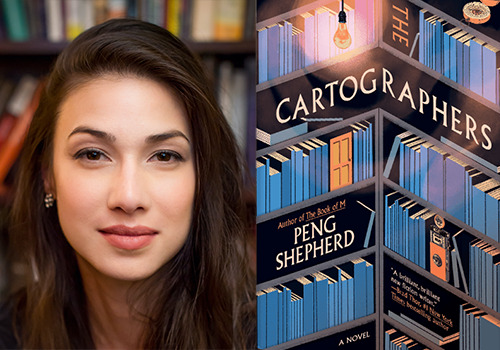
NaNoWriMo can seem like a daunting task sometimes, for NaNo newbies and veterans alike. Fortunately, our NaNo Coaches are here to help guide you through November! Today, author Peng Shepherd is here to share her advice on how to set yourself up for noveling success:
Welcome to the middle stretch of the NaNoWriMo challenge! Whether this is your first NaNoWriMo or you’re a seasoned, ink-stained veteran, and whether you started strong right out of the gate or it took you a little bit of time to warm up, we’re well on our way with this journey now—and reality might be starting to set in.
Beginnings are the easiest part of a novel, I’ve always thought. It’s just you and the blank page and your excitement. Anything is possible! You can do whatever you want! It’s easy to lay down words in a frenzy because you’re building from nothing, so nothing has to make sense, nothing has to pay off, yet. You’re just trying to get from “zero” to “something” as fast as you can.
And then eventually, far in the future, the ending of the novel will come. And at that moment, even if you’re exhausted, you’ll have so much momentum and you’ll know your characters and story so well that you’ll be hurtling toward that finish line—possibly even faster than when you started the story, full of inspiration and still unsinged by the first flames of burnout.
It’s the middles the are the hardest.
Those meandering, saggy, slow middles.
The problem with middles is that by this point in the manuscript, your draft actually might be starting to look like a book-shaped thing. And while this is great in terms of progress, it’s also really tough in terms of morale. Because for the first time, there’s finally enough material that you can see how messy, confusing, and seemingly unsalvageable what you already have is… and also how much farther you still have to go.
Then, life gets in the way. You miss a day or two, and fall behind on word count. A work emergency happens, or your laptop goes on the fritz. Friends need help, you realize you have to delete ten pages, then the roof starts leaking. And your plot still doesn’t make any sense, your characters won’t behave, and you have no idea how to fix any of it. You’re lost, you’re exhausted, and you’re still nowhere near the finish line—how did you think you were ever going to write something as gigantic as entire novel? It’s impossible!
There’s a little piece of advice I give myself at overwhelming moments like these:
When the goal or the pressure feels too big, go small. Really small.
A book is a huge thing. It’s way too big to hold in your head like that! Trying to face a goal of that size every single day you sit down can crush you.
So, don’t think about the whole picture. I like to tell myself, I’m not writing a book today. Or, I’m not writing a first draft today. Or even, I’m not writing a chapter today. Instead, I tell myself, I’m just writing this next scene, or, I’m just changing her location from Chicago to San Francisco.
Or, in this case, I’m just writing 1,667 words today (or whatever your session goal is).
This advice helps me remember that I indeed do not have to write the entire book in one day. I just have to write a single scene, or fix a single thing. I’ll worry about tomorrow, tomorrow. And I’ll worry about whether the draft any good or not, or how to revise it, even later than that.
So, if you’ve been struggling lately or feeling crushed under the weight of your goal, I invite you to try this tactic. Right now, or after work, or later tonight, find a few minutes and open up that laptop or notebook. Don’t reread what you wrote last time and start tinkering to make it better, don’t review your outline to confirm things are still making sense, don’t take stock of your progress to see how much you have left. Don’t think about the rest of the manuscript and how it all has to connect. Just think about the part that’s right in front of you. The scene that you’re in right now.
Remember, you’re not writing a whole book today. You’re not writing a whole chapter today, even.
You’re just writing this one small scene.
Now, onward! Because the only way out of a middle is through it.
Peng Shepherd was born and raised in Phoenix, Arizona, and has lived in Beijing, Kuala Lumpur, London, New York, and Mexico City. Her second novel, The Cartographers, became a national bestseller, was named a Best Book of March by The Washington Post, and received a fellowship from the National Endowment for the Arts. Her debut, The Book of M, won the Neukom Institute for Literary Arts Award, and was chosen as a best book of the year by Amazon, Elle, Refinery29, and The Verge, as well as a best book of the summer by the Today show and NPR’s On Point.
103 notes
·
View notes
Text
Hmmm, interesting. Thanks for your take!
For me, the reason why I like “shittier draft” is because it gives me permission to do it badly. Almost like… “I *meant* to do it that way”. Sure, I’ll be pleasantly surprised if I come back to edit and find some gems there, but “shitty” is a vibe for me more than just a quality or moral judgment, so I expect it to seem rough around the edges and let myself do more experimenting or “good enough” stopgaps to get it done. Whereas “worst version” actually feels… to me, the same way “shittiest” feels to you! Like that’s not a vibe; that’s just a statement of quality. The worst version. It doesn’t matter that it’s relative; it still feels really bad even if it’s true. Calling something a “worst version” or “worst draft” would actually sap all of my motivation and morale to work on it.
All this is to say, it’s really interesting how different words can have massively different impacts on different people, even if we agree on their definitions.
Anyway, part of it might be things like.. I’ll say “oh this is so shitty but I love it”. The word with respect to quality kind of evokes grittiness, like “oh this isn’t smooth but the potential is there. Shaping and honing it will be fun but so is just getting it out there.” Whereas I’d never say “this is the worst but I love it.” To me “worst” carries more of a sense of… “irredeemable”, even though that doesn’t necessarily logically follow.
Also “shitty”, when I say it about my own work, doesn’t really bother me at all. It has no harmful impact and instead just lowers my expectations, which makes the process more fun. Slapping a “shitty” label onto something lets me know that this is the “quantity over quality” zone where I can dick around with things.
“it just needs to be done” doesn’t really work because it’s a mouthful and also not an adjective. It’s also not accurate! It implies I’m just trying to get it over with, like the process is a struggle but as long as it’s done that’s good. When I’m doing something shitty, the process isn’t a struggle. It’s just deliberately not trying to be good. And that feels a lot more fun! Whereas the “done version” (idk what one would call it) makes it sound like a boring slog that I definitely wouldn’t want to keep working on.
I’d never heard of “zero draft” before your post and checked out your posts on it. It sounds interesting and I’m really glad there are people it works for, but WOW that could not be me! I don’t even number my drafts at all, usually; I edit as part of the writing process (I.e. go back to read a previous scene to refresh myself on what the vibe was and where I left off, only to end up revising the scene because there are parts that need work). So it’s all one continuous first-to-final thing, until I’m at least halfway through and a really huge change comes up, and then I make a new file so it’s easier to delete big chunks and replace them. But if it isn’t halfway through, then I just move the big chunk to a section called “deleted scenes” and write the new chunk right there, making it still part of the same draft. Now that I think about it, I don’t actually use “shittiest version” at all, so oops on misleading! I’ll just classify works as “this one is ‘shitty’”, as shorthand for “this one has absolutely zero expectations, do whatever you want, write it all in dialogue if you want, or do half of it in comic sans”. And others as “no this one is actually good, so you have to be in a more serious mindset to do it, and it’ll be slower because you’re being a lot more deliberate and planning what to do, and also the structure of the plot is already in place and the style is already set so you’ll have to match both until it’s done and you start editing”. For those, I don’t actually like “playing” or experimenting, because that’ll just slow things down. I’ll come back to it and find it doesn’t fit, or it made the story way longer than I wanted it to be, and the extra length isn’t doing anything. So it needs to be tight. And I know some people hate writing immediately like that, since “that’s what editing is for”, but I don’t mind doing that sometimes; it’s a different form of fun for me. I’ll still go back and edit afterwards, but being deliberate from the very start is challenging and interesting in a different way than… being shitty 😅
I'm so glad Tumblr brought me across the guy who won't let people talk bad about their singing voices because I am his sister in another artistic line.
"It's my shitty draft."
No! It's not shitty, it's just early in the writing/rewriting process!
18 notes
·
View notes
Text
How to Write Faster: 13 Tips for Becoming a Faster Writer
Write every single day. Writing is like a muscle—the more you exercise your craft, the stronger, leaner, and more efficient it will be. Setting aside daily writing time is important even if you aren’t on a deadline. Work a writing session into your routine—make it a habit—and consider building ritual around it, like relocating to a special location or making a cup of tea.
Give yourself a topic. You may already have an assignment or personal writing goal that you’re working towards (like the rough draft of that novel), but if you don’t, zero in on a single area of interest that will kick off the writing process. It’s commonly assumed that writer’s block comes when you’re out of ideas, but it can also hit when you’ve got too many to sift through.
Create an outline. It may seem counter-intuitive, but spending time getting set up before you start writing can save time in the end. Make a plan, plotting out the main points of your writing project and getting a sense for word count. You’ll not only always know what comes next, but also exactly where the finish line is and how hard you need to push to get there.
Gather information. Writing fast is all about removing impediments to the writing flow. Do any necessary research in advance and drop relevant facts, quotes, anecdotes, or ideas into your outline for quick reference later. This will decrease the amount of time you spend staring at a blank page trying to recall what it was you meant to say and how you meant to say it.
Get rid of distractions. Close browser windows, email programs, and chat apps. Unplug your computer or even your router. Turn your phone to silent and place it out of view. Even if only for an hour or two at a time, do whatever it takes to nurture a healthy writing habit.
Set a challenge. Can you write 1,000 words in an hour? How about 500? First-time writers or people with busy schedules might start out with an easily achievable goal like 50 words per day, while professional writers will benefit from hourly or minute-based objectives. Either way, incrementally increasing your target words per minute (WPM) can improve your writing speed.
Start a timer. Whether you’ve got the kind that you twist, a digital device with buttons, or an app that you load, starting a timer at the beginning of a writing session can help a great deal. Not only can you track your progress as you meet new writing challenges, but you’ll be less likely to procrastinate—it’s hard to waste time when you’re aware of each passing second.
Revise later. Great writing rarely arrives fully formed as a first draft. Give yourself a break. Let typos slide, ignore the spell-checker, steer away from perfectionism. If you get stuck on a particular phrasing, write it plainly and come back to it later. You can lose a lot of time editing as you go, so rather than re-reading every step of the way, save the revisions for the end.
Use placeholders. Even if you’ve filled your outline with well-researched points, the act of writing will take you places you hadn’t planned. If you stop your flow to look up a fact or idea, you risk wasting time going down research rabbit holes. Instead, use a placeholder like “TK” (which means “to come”) and replace it when you’re done writing.
Stop while you’re ahead. If your timer goes off and you’re mid-sentence, that’s actually great news. Rather than rush to finish the thought, leave it for the next day. This means that when you return to the page, instead of staring at a period and a flashing cursor you can jump back into the flow. Sometimes becoming a better writer is just a matter of forming new habits.
Find your best time. For all of the practical tips and writing skills you can learn, improving your speed can also come down to your own biology or psychology. You may be an early riser who writes better and faster in the morning. Or you may be a night owl whose mind feels most fluid in the wee hours. Experiment to find out what time of day is most productive for you.
Seek good posture. Similarly, the way your body is positioned can affect your work. Sit with a straight back and your elbows at right angles to the keyboard. Slouching or having your arms in the wrong position can lead to fatigue and cramping—enemies of fast writing. Some writers prefer standing desks, which have been shown to increase blood flow and energy.
Play typing games. Even if you’ve internalized all of these writing tips, it’s possible that your fingers simply won’t be able to keep up with your mind. There are various free online typing tests and games designed to help you improve your typing speed. In the process, you can work on getting your fingers in the right position to maintain a flow free of interruption.
Article source here
#writersociety#writers of instagram#writer community#writing#writers#write#writing tips#writing advice#amwriting#writing life#writeblr#writing analytics#writer#writer stuff#writing excersise#Writing Theory#Pacing#Writing pace#Writing pacing#Writing advice writing reference#Writing reference#writers of tumblr#tumblr writers#writers of the world
70 notes
·
View notes
Text
Editing and Levels of Editing
Before I begin, I wrote this whole thing out this morning, pressed save as draft and guess what post did not save as a draft? Yeah. So if it feels a bit more dry or to the point than my usual posts, I apologize. And if you prefer it like that, tell me, because I’m great at accidentally losing drafts!
This post isn’t about how I edit (I’m sure I’ll do that eventually), it’s more about how much I edit and specifically how that changes depending on what I’m writing.
So I measure how much I edit by drafts a lot of the time, but that isn’t entirely accurate because there are drafts and then are drafts. When I’m writing a book, I write a first draft, I write it carelessly and without looking back, then I start over for my second draft. That’s what I’m going to refer to as a solid draft, when I write the whole thing out again.
For my third draft onwards I’ll usually be editing the second draft, editing could involve cutting out whole paragraphs and writing them again, but I’m not starting from zero. This is what I will call a soft draft.
Now, organized from most to least drafts:
1.- A to be sold book. At this time, that’s just Dear Dragon and the next books coming up in that series. People pay money to read this, so it has to be good. And what each person considers good can be relative, for me, it’s generally around seven to nine drafts. Two solid drafts and the rest soft drafts. My first book took me about twoooo yeeeears (voice full of hesitation), technically three but with long hiatuses in between and… it’s a mystery for the ages, I’ll be honest. The point is, lots of editing, lots of work. Obviously you aren’t going to put as much time into every work you do.
2.- A not be sold book. So, because I’m one hundred per cent incapable of doing a single project at a time, sometime after my beta readers received Dear Dragon, I started to write another shorter novel, it was an idea I’d had running through my head for about two years or so, and I just wanted it out.
I knew this wasn’t going to be anywhere near the quality of Dear Dragon, if only because I was nowhere near as in love with the idea. So as to not put pressure on myself I thought, I’ll upload it to Wattpad, it’s a social media site for writing, maybe I can get my writing noticed a bit before publishing my actual novel…
I’ll do a post about the different social media sites and being an author on social media at a later date. Once I feel like I know what I have to say because… I have a lot to say.
But anyway, it’s going to be free, but it’s still a proper little stand alone micro-novel. How many drafts? Three. In my case, three. It was a solid first draft, solid second and soft third draft. It took me about a year with long hiatuses in between because as said previously, it just wasn’t high on my priority list.
It’s complete from today (if I’m doing the maths right because I don’t publish these on the same day I write them)! Check it out.
I recommend binging it because that’s how you get the most out of the small details.
3.- Chaptered stories that don’t stand alone. I actually have two stories that fit into this category: Oppida Institute for Reformation and Love, Coffee and Dragons. They are both prequel series to my main book series Dear Dragon.
Now, I do less editing in these then I will a not for sale novel, BUT, I do a lot more plot related editing. What do I mean by that? I spent a lot of time double checking timelines, maps, general continuity. See, because this takes place before the main series, a lot of it affects the main series, so I have to be cautious not to make any mistakes.
In both I do a solid first draft and a soft draft, in this soft draft I mainly work on catching any grammar mistake, touch up on fluidity and double check timelines and maps.
For Love, Coffee and Dragons I write my first draft in word and then edit it another day in Hemingway.
For Oppida Institute for Reformation I will export it from word to my iPad, edit it by hand and then go to Hemingway to pass those edits on. This means I read through my draft about three times instead of two. Mainly because the plot elements affect the main series more than Love, Coffee and dragons which is, what I call an emotional support story (I’ll probably do a post about what I mean by that… later).
These both probably take me a couple of weeks for each Act, which will be somewhere between five and fifteen chapters. I upload each chapter once a week so. That works well.
4.- One-Shots. I do plenty of quick one-shots, Market Day or Photos that follow my book’s main character as a child. Night Out which follows one of the old kings. And every article up on my web.
Because everything I just mentioned is in the universe of Dear Dragon (beginning to think I need to branch out a bit) my editing is mostly double checking everything is properly placed on the timeline (guess I should do a post about how I write and keep track of the timelines, huh?). I revise grammar but don’t tend to go over fluidity as much as the other stories.
Because there one-shots are usually low stakes and more just an exploration of something simple, such as the terrifying feeling of not knowing where your parents are at the market, they usually are written and edited the same day or not long after.
5.- Blog Posts. So, this. Before here I used to do some writing tip posts on my site, I also have my personal tumblr where I usually ramble on about existentialism and whatever comes to mind. For these posts I write them (solid first draft) and then I read them over, add in links, make things bold and try to catch as many typos as possible. I probably don’t catch all of them and often click edit if I spot one.
But that’s fine, because I’m trying to upload one a day, so it’s not supposed to be this high quality experience. It’s just me trying to share the most useful bits and bobs from my own experience.
This takes me probably an hour or so depending a lot on the article.
So, did you get anything out of this post? I’d not heard anybody talk about the difference in effort you put into different works and thought it might be interesting, but in retrospect maybe nobody talks about it because it’s precisely the opposite. You tell me! Feedback and criticism helps me know what I should be putting more time into.
#writing advice#writers on tumblr#writing#how I write#writer#writing tips#writing tricks#tips#tricks#editing#selfpublished#author#authors#can someone tell me the kind of tags I should be using for these posts?
7 notes
·
View notes
Note
Sorry for the essay I'm about to submit. I haven't watched any rvb0 yet, but I think the change in direction may be for a few reasons; 1- buying time so they can figure out what to do with the OG RVB cast without rehashing the same stuff, doing justice to their characters AND appeasing the fans who demand a Red based season (am one such fan).
[continuation of ask] 2- To attract new fans into the series. Ye Olde RVB jokes and running gags were considered typical, if not an accepted form of comedy for it's time. Whilst some people will be able to see it as a product of it's time, those jokes definitely will hit wrong with a younger audience now, and We've had the opportunity to grow and change ourselves and our opinions alongside the show. The action heavy stuff has a broader, if not safer appeal, so bringing in new fans will be easier. I miss the dumb idiots playing in a box canyon, and I agree that rvb shouldn't be driven by action. A bunch of idiots with guns and fuck all else to do is the very basis of the show, but those idiots have outgrown their sandbox and the writers seem to be reaching the end of their idea rope on giving them shit to do. Don't be scared to express your opinion here either, you are definitely far more polite about it than some others I've seen. [end ask]
It’s pretty funny to receive this ask today, because literally spent hours preparing a review of Zero today. A review I of course won’t post until after the entire season is out, because I cannot judge anything before that, and I will of course revise due to this and so much of it still needs to be written, but there are main problems I could address already now, or at least prepare a draft for. So pardon me that I copy paste part of the review here, I just like some of the points I made, and then I don’t get to rewrite thoughts I’ve already had.
It makes sense to have more time to prepare for a quality season. I do not know if that’s the case. I hope it is. I get wanting new viewers, but I feel like this doesn’t necessarily means *more* viewers because people interested in the new season are literally being told they don’t have to watch the previous seasons, while fans who prefer the old style of RvB are being told this season is not for them. So if the Reds and Blues ever return, the people interested in Zero are gonna be so confused, I suppose. Urgh. No reason speculating about that until we know. As for the old humor – yeah, I get that, but I feel like there’s starting to be a great divide between “RvB” and “Zero” and that worries me. So if it’s just to make time for planning a season with Reds and Blues, I keep asking if Zero is necessary.
I would feel way better about Zero is it just presented itself as a spin-off, but for some reason, they cling to it not being a spin-off. This confuses me to no end, and so many of the issues would be solved by officially stating this divide from canon material. My main problem with Zero right now is this: [taken from the unfinished, unrevised review] “Zero forces its story into existence by ignoring established content rather than adjusting to it. Let’s call this for the hotdog-too-big-for-the-bun syndrome solely for the sake of the bow-chicka-bow-wow that’s coming now. Bow-chicka-bow-wow.” With this I mean like this story forces its way to exist at the cost of canon content. Examples of this being the sudden new inclusion of AOD which we’ve never heard about before, that sorta takes the place of UNSC, but is so big, but we’ve never heard about it? Another being how the very first lines erase the consequences of the previous season by fixing Wash’s brain damage. It’s literally ignoring established plot with quick-fixes so this new story can work. Another example how I feel like Wash and Carolina are just there for the sake for the new characters. I don’t dig how they’re written, it feels like they are just props the new characters use to build their own story. Carolina’s used to basically introduce and explain the new characters instead of letting them explain themselves, and Wash is just a damsel in distress, holy shit Wash, RvB is never kind to you huh. I just feel like the existing RvB is twisted into something else or ignored, so that this story can exist, and I am left feeling: why?
It’s obvious they wanted something *new* which leads me to another issue for me: [taken from the unfinished, unrevised review] “remember the philosophical question: if you replace all the parts of a ship one-by-one, is it still the same ship when you’re done?” If it doesn’t include the Reds and Blues, if it ignores previous plot, if the old characters feel miswritten, if it values animation over dialogue, if it values fight scenes over comedy, if it wants to be Fast and Furious instead of Red vs. Blue – is it still Red vs. Blue? Because it doesn’t feel like it for me.
As I said earlier, some of this could be forgiven if it established itself as a spin-off, but it won’t despite fighting against the original characters and material. At least, that’s how it feels like to me. We’ve had spin-offs before. With new characters and stories.
Some people say that RvB should end. I can’t comment on that. Some say the Reds and Blues have run out of things to do. That I disagree with. [taken from the unfinished, unrevised review] “I mean, if we were discussing pretty much any other show, I’d probably agree that they were running of out content. But for the Reds and Blues… I think the PSAs nailed it this year! I’m not kidding, I had more fun watching the Reds and Blues discuss how to do laundry than Zero. You could literally give me an hour of the Reds and Blues trying to bake a cake or clear a gutter or simply setting down with an ordinary life, and I would trust them to make it worth the watch.”
I’m not saying Zero can’t be enjoyed. I’m not trying to spoil anyone’s fun. But for me, there are some obvious problems that I simply can’t come to terms with, and I will post my opinion, of course always trying to stay civil. I’m glad you enjoy my thoughts (so far, at least. I hope I haven’t pissed anyone off with this), and as always: I can only speak for myself.
#rvb#rvb0#rvb zero#rvb critical#rvb0 critical#pls dont hate me for this#ill of course elaborate more in my review#which of course isnt finished until the show#cant judge anything properly until then#my rvb stuff#can be reblogged#why do i feel so scared posting my thoughts on zero
48 notes
·
View notes
Text
roscoe’s notebook post
A while back I said I was going to write a post about the way I use notebooks for writing projects. This is the first of several posts about Writing Process I’ve been tossing around in my drafts for a little while as a result of conversations with friends, so bear with me.
I. Love. Notebooks. I genuinely would have to deeply overhaul my whole Process of writing anything on the longer side if I were to go paperless; I find physical paper pretty invaluable when I’m outlining, brainstorming, and researching, and I still probably write ¼-⅓ of all my actual content on paper first. (That proportion used to be a lot higher, but I’ve gotten better at being productive on a computer in recent years, which is great.) I’m a very visual person, so notebooks really help me visualize my ideas, story structure, etc. It’s very helpful to be able to use arrows and diagrams and physically strike things through, and the tactility is really soothing to me. If I show people my notebooks or talk about them, I often get a response like “this is so organized”, which is sort of true, but I have to stress that it’s “organization for a disorganized mind”; I can’t misplace ideas or notes if it all goes into the same physical object, vs. electronic notes, which are much more, like “Did I say that in a voice memo? PM it to myself on Discord? Leave it in a desktop sticky note? Write it directly into the Google Doc? Who knows! It’s lost to time!”. It’s very much an ADHD management strategy.
It helps that I’m a very neophyte stationery hobbyist and appreciate any excuse I have to use my pens, but I also will go off at any opportunity about how helpful I find them for writing projects, which is why I decided to just make a post about it. Right now I mostly use them for (fan and original) fiction projects, but I used a notebook for a very similar purpose when I was working on my undergrad thesis, and I have a slightly different but equally necessary-to-me approach to notebooks I use at work.
My typical structure for a notebook that’s devoted to one project only looks like this:
I always leave the first couple pages blank so I can go back and retroactively index bujo-style. I don’t always actually do the index, because sometimes I get too lazy, but I like having those blank pages there to give me the option. I also usually put epigraphs/inspo quotes on the first page.
After that, there’s often (but not always, I’ll talk about it) a couple pages at the start where I’m frantically jotting down loose brainstorming ideas before they've coagulated into a story structure. Just, like, vomiting into the void.
Stemming out of that, I usually write out about like 5-10 pages of outline-style notes in chronological order, laying out all the main story beats and charting out the story trajectory. This will inevitably get revised and rewritten many times, but I find the process of writing these wide-angle synopses really useful for dislodging ideas, making connections re: thematic threads, etc. from my brain.
I’ll devote a couple pages after that to specific things like "sex scene brainstorming", "random scene ideas/minor details that don't have a clear place in the outline right now but I'll turn to for inspo later" [this is what I refer to as “bits” in one of the later photos], "page where I just outline the Motifs And Themes", "research notes", "to-do list", "stuff to check on a second pass", "things to put in the a/n and AO3 tags", etc.--the specifics vary with the story.
Then, I skip ahead to approx. halfway through the notebook and cordon off the rest of the pages to be “free writing” space, AKA writing of actual content rather than planning, with the expectation there will be no internal organization and I’ll transcribe to laptop as I go. Writing on paper feels less binding than typing something on a computer; it’s like a little secret kept with myself, and it doesn’t need to go anywhere or be seen by anyone if I decide I don’t like it. Setting aside pages in the back half of the notebook means that, as more things come up re: planning, I can go back and add those in the rest of the pages that were intentionally left blank. This is how I avoid (for the most part) having the whole thing be a jumbled mess where there’s no separation between the notes and the actual story writing; I learned this the hard way via the first notebook I’ll show you in a second. I’ve recently gotten really into using Muji sticky note tabs to label any pages/sections of particular import that don't want to have to refer back to in the index and would rather just flip to instantly.
I do use notebooks that aren’t specific to any one project, but those are much less organized and less worth sharing.
Before I look at more recent stuff, here are some selections from my notebook for the project that got me into writing longfic, my Golden Kamuy canon divergence AU (with apologies for the bad photos, my phone’s camera is trash). I worked on this from Sept 2018-July 2019. It was a learning experience in a lot of ways, and notebook utilization was one of those. I’ve always used notebooks for keeping track of writing projects, as I said earlier, but before this it was largely without much organization or structure; just total chaos. Having a physical notebook became really important for this project because it was a sprawling multichapter story with rotating POVs and a lot of historical research. I also learned a lot about what not to do with a notebook, personally, or at least things that don’t work so well (for me). This was a college ruled spiral-bound Decomposition Book, for the record.
By the time I bought a notebook for it I already had a (very basic) plot outline in mind, so I wasn’t doing that very initial ground-zero brainstorming in here; I was copying out of my phone’s notes app, basically, and then going from there.
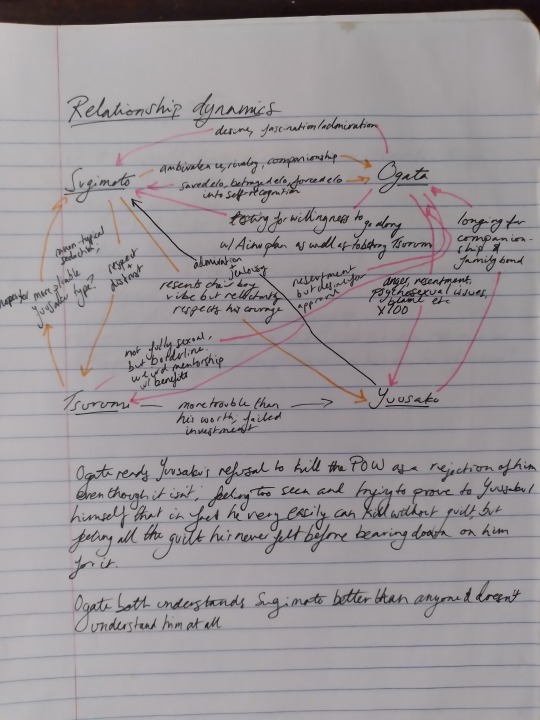
This is one of the first pages in this notebook; I wanted to visualize the relationship web between the four central characters in the story in terms of how they feel about one another. The two colours correspond to the POV characters (Sugimoto in orange, Ogata in pink), and I used this colour-coding throughout the notebook with highlighters, etc. to keep track of information that was more relevant to one character than the other. Tsurumi and Yuusaku aren’t POV characters, but they’re prominent in the story and their presence impacts the central relationship between Sugimoto and Ogata, and it was helpful to me to map out the emotional ecosystem, as it were.
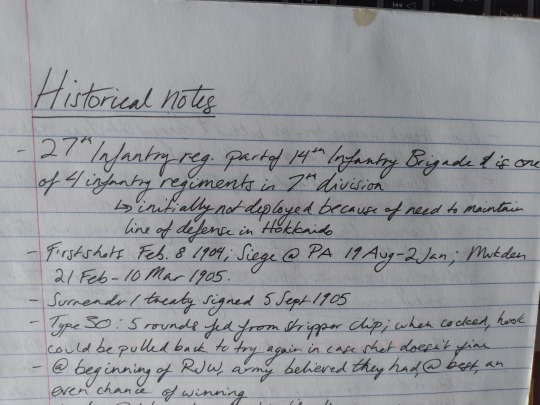
(There are coffee stains all over this, because I wrote the vast majority of the story in coffee shops because I didn’t want to be around my roommates, lol. This is part of why I never do fiction writing in notebooks that are too nice, I get neurotic about needing to keep them tidy. I can’t use ones that are too shit though, either, so it’s a bit of a narrow window. I’ll talk more about brands and paper quality etc. later.)
As you can see, this is the first page of many I set aside specifically for jotting down different pieces of historical information relevant to my story. It’s about fictional characters who are members of an army division that existed in real life, and both the canon and my fic involve a high level of attention to detail with regards to which divisions were present for which battles, etc., as well as general historical details specific to the Russo-Japanese War setting--what did people eat in the trenches? What did they do to fill time? How did they get through the winter? What did third party observers have to say about the conditions? What were the specs of their weaponry (particularly important because one of the POV characters is a sniper and gun nut)? I did a lot of reading (and watching of antique gun collector Youtube videos... the things I do for love, eh), and it came in handy so many times, because it turns out it’s much easier to write trench warfare slice of life if you have factual details to pull from when you don’t know what to do with a scene! Imagine that!
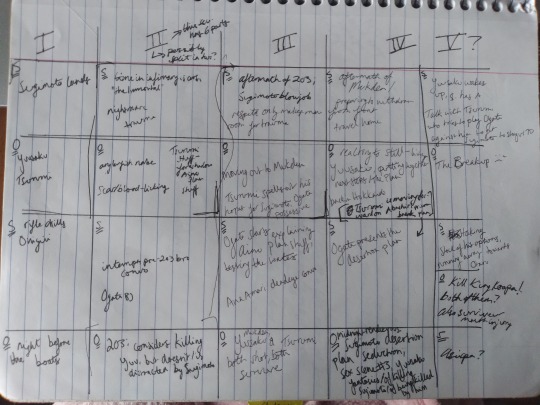
This is the first of three “grid outlines” I made; this is a way I sometimes like to visualize a story outline all on one page, with the columns representing chapters and the squares within the columns representing sections/scenes within the chapters. As you can see, early on I was hoping to get this done in five or even FOUR chapters (whatmakesyouhaha.mp3), with POV switches happening internally within the chapters. This proved to be unwieldy for many reasons, so I revised the outline:
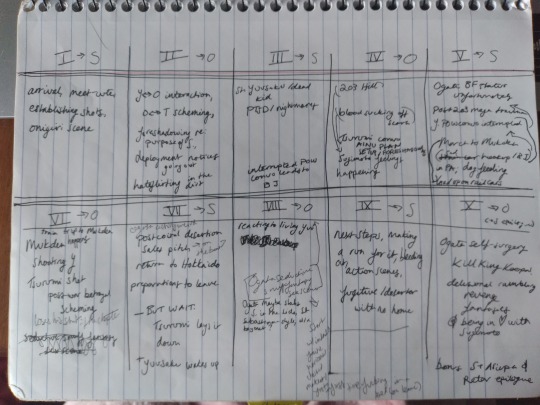
Here I’d come to terms with the fact this story was going to have a lot more chapters than I’d planned, and I rearranged things so that it would happen in ten, with each chapter belonging to only one POV character. This also needed revising later, and in the end the story looked a bit more like this (though it did in fact end up being twelve chapters, but only because Chapter Ten was like, 12k, and needed to be split in two chunks):
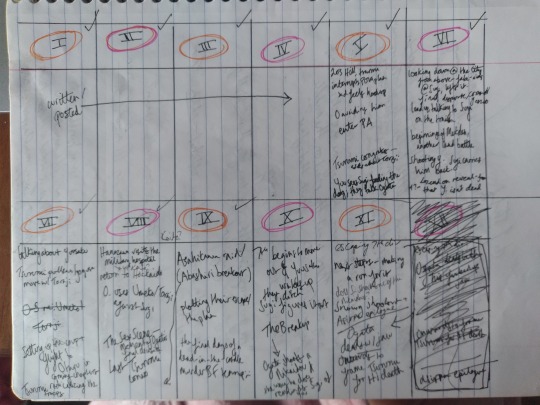
I must have remembered to bring my fineliners to the coffee shop this time, lol, because as you can see it’s properly colour-coded this time. This outline was made when I was already four posted chapters into the fic, which hopefully gives you a sense of the way in which I am sort of a planner and a pantser; I can’t get into a longer project without an outline, but the outline inevitably changes many times throughout writing and I often end up with a finished product that looks pretty different from what I was intending. My creative M.O. as always is Do The Maximum! Amount! Of! Work! Possible!
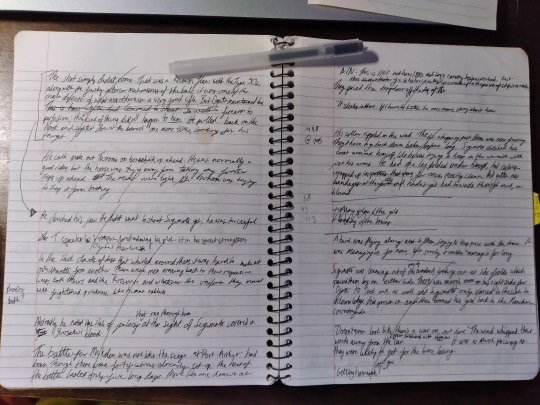
This is what a “free writing” page looks like, for me. In this notebook I didn’t set aside any specific spaces for free writing so it’s strewn throughout the notebook in a really disorganized way and I was constantly flipping through looking for bits I’d written and forgotten to transcribe, and I decided to be more organized in future as a result of that. If something’s crossed through, that means I transcribed it. As you can see, they’re often small sections, sometimes just a coupled decontextualized sentences. About 3/4 of what I write in a notebook makes it into the story, I’d say; some of it never goes anywhere, and that’s OK. I have less of an issue killing my darlings if they never make it off the paper page.
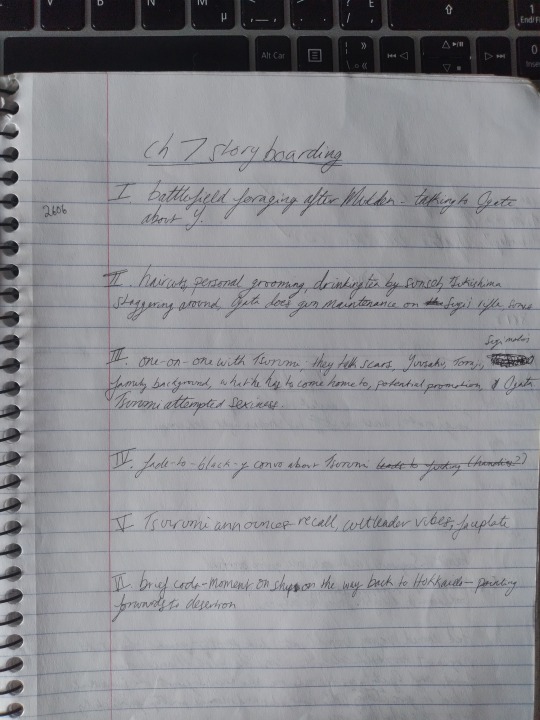
A very brief, top-down chapter outline, where the goal was not to get too bogged down in details and just to visualize the beats and pin down what they’re trying to accomplish. Chapters for this fic typically ran about 6k, and five or six scenes per chapter was pretty common, so the average scene length was about 1-1.25k words/scene. IDK why I called it storyboarding when I didn’t make drawings. (Margin numbers are to keep track of word count, since I was using a daily word count tracker while writing this.)
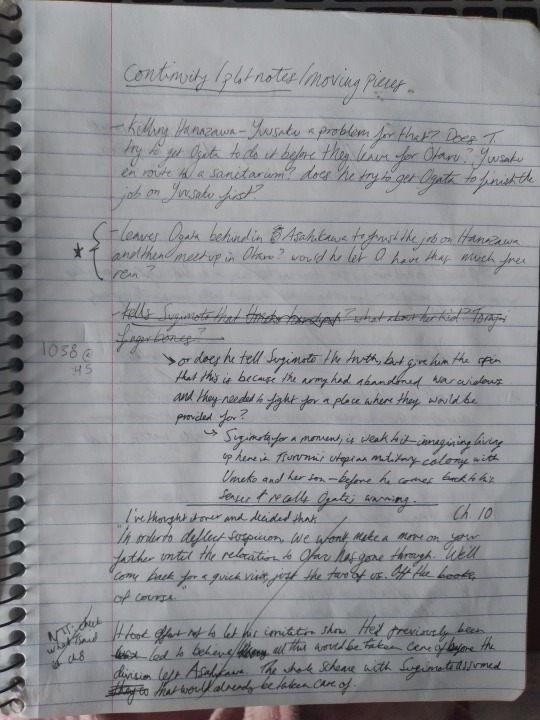
This page was, as titled, for keeping track of the various balls in the air when I was about 2/3-3/4 of the way through the story and really feeling the pressure with regards to tying up the various loose ends. This was... a struggle. I hadn’t ever written anything longish (this fic ended up just under 70k) that had an action plot before, let alone a canon divergence scenario where I had to engage with and explain away various canon plot elements so I could maintain the audience’s suspension of disbelief.
Now, I mentioned earlier that I learned various “things not to do” with my notebooks while working on that project. One of those lessons I learned is to be more realistic when assessing how big a project is likely to get, not least because I RAN OUT OF PAGES around the chapter 9-10 mark. In my defense though, that’s because I’d never written anything even half this long! But I know better now, and try not to be in denial. Finishing the notebook early was a way bigger problem than I’d anticipated, and was part of the reason the last few chapters took several grueling months to finish. The issue was that I needed to be able to use a notebook to maintain my workflow--attempting to do it only on a computer was dismal--but it seemed silly to start a notebook of a similar size to the one I’d finished (80pg, approximately B5 dimensions) when there was no way it would need that much space, especially since the reference pages, like the historical notes, didn’t need to be transcribed over. I was also pretty broke at the time and didn’t want to spend money unnecessarily, lol. I tried to get by using a Moleskine Cahier for a month or so because I had one lying around, but it was horrid; it was too small to be used comfortably, it wasn’t spiral-bound so it wouldn’t lay flat, the ghosting is terrible and I hate the way Moleskine paper feels, etc. Eventually I caved and went to Muji and bought a 30ish page A5 with closer to lay-flat binding, and I finished the story in there. I would take a comparative pic for you of the relative notebook sizes and include some of the scene staging diagrams, etc. I put in there, but I can’t find it :(
So I learned that specs really do matter, and it’s okay to be picky if the pickiness is going to make the difference between actually using a notebook or not. Things that are important to me in my notebooks:
Ruling (gotta have ruling, I can suffer through grid but blank or dot is a no-go)
Size (I can’t use anything smaller than at least a medium-large notebook, I find it claustrophobic and get miserly about page space)
Binding (twin ring is my preference because it looks and feels better than a classic spiral but has the same comfort of use with regards to bending the pages back to suit workspace size and laying flat with ease)
Paper quality and colour (I don’t like anything too slippery/smooth or with too much visible ghosting, and I strongly prefer an off-white paper to bleached paper--part of why I don’t use Decomposition Books anymore, the paper is scratchy and it’s too damn bleached!)
Pagecount relative to size of project
Portability (in non-COVID times; anything bigger than a B5 wouldn’t fit in the satchel I used to bring to work at my old job), etc.
But everyone’s taste is different in this respect, and the only way to figure out what works for you is through trial and error, I’m afraid. I also suspect I’m more neurotic and particular about the sensory experience of using a notebook than most people are, but I yam what I yam.
Now to talk about the notebooks for my current projects, where I’ve refined my approach somewhat. I’ve included less photos for these because they’re ongoing WIPs I don’t want to spoil completely, but I’ve tried to include some outline-type stuff to give you an idea.
My big bang fic is in the very ugly twin ring notebook on the right; I got it at a dollar store by my house because I needed something to work in and didn’t want to wait for an online order, but it’s been very serviceable for my needs. The paper isn’t even bad. The bigger notebook (B5) is my Sangcheng fic.
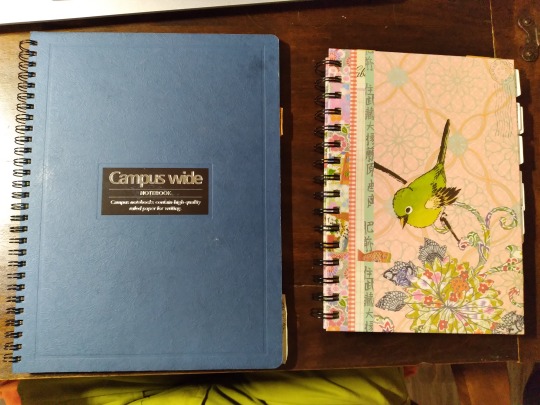
I wanted something with a lot of pages for this, because I knew it was going to be a long story, and for some reason the fact it’s smaller than my usual preference doesn’t bug me (I think it’s an A5?); it just fits this story, somehow. I’m not sure exactly how many sheets are in here but I’d guess about 150.
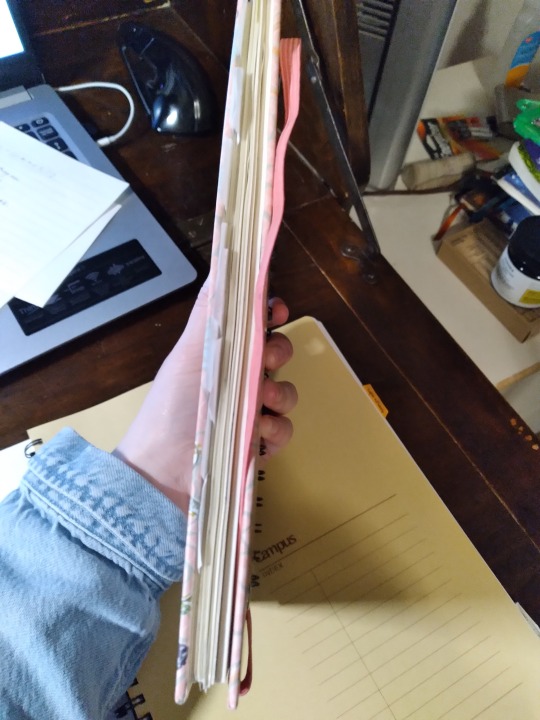
Because this notebook has upwards of 100 sheets, I made a lot of use of sticky-note tabs to label high-priority pages. The colour coding of these doesn’t mean anything, it was just whichever ones I had at hand at any given moment. These are those tabs from Muji I mentioned, I’m really obsessed with them--the shape makes them so much less obtrusive and more practical than conventional squares/rectangles OR flag shapes, IME.
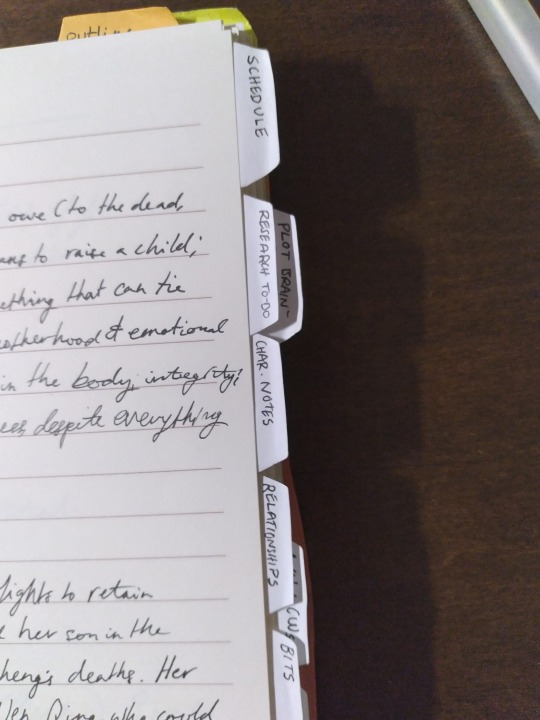
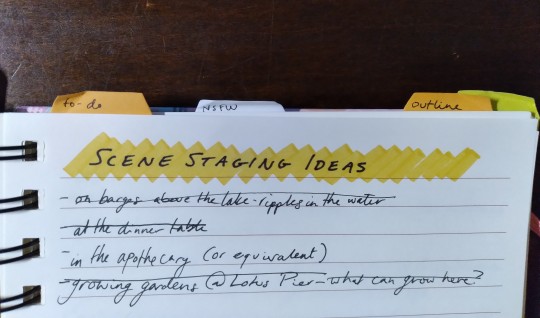
My big bang story is nonlinear, so, similarly to what I did with colour coding for the two POVs for my GK fic, this story has two main colours corresponding to whether a given section takes place in the “before” or the “after” portions of the timeline, with blue as “after”, yellow as “before”. This is what the most current version of the outline looks like in there:
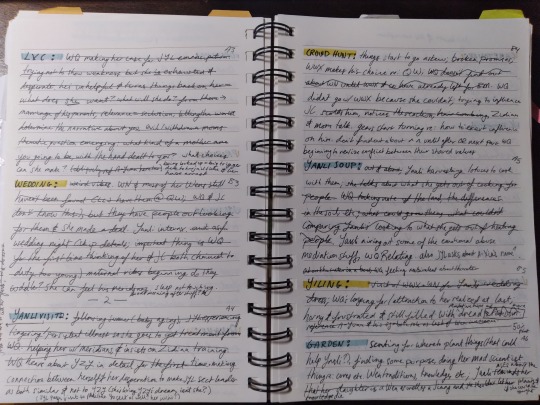
If you squint, you can see the alphanumeric notes in the top right of each section entry; I gave them each a code like “A3″ or “B5″ corresponding to their position in the story sequence (so, it goes A1, B1, A2, B2, etc., through to B9 and then the epilogue). [Unintentional that this schema overlaps with notebook size labeling and so is kind of confusing in the context of this post.] At first I was just keeping track of the sections via the highlighted titles, but it got confusing because I’d write down “Wedding” or “Yiling” in my notes and then refer to the notes later like “but there are multiple marriages?? and multiple scenes in Yiling??”. Stuff gets struck through with a straight line if it’s been written in a more-or-less complete form and crossed out with a squiggly line if it’s been cut from the outline or made redundant.
As I said earlier, I started out all the initial brainstorming for my Sangcheng fic in its notebook, instead of brainstorming it in someone’s DMs/my notes app/a voice memo/etc. and then transcribing it into the notebook in a somewhat more organized fashion, which is how my stories usually start out. Because of this, the first five-ish pages are basically just stream of consciousness rambling where I was trying to jot down every disconnected thought I had about the story concept. I don’t have photos for that because it’s too spoilerific for later developments in the fic, but I can show you some of the stages the outlines went through, once I was able to corral those initial notes into a story structure:
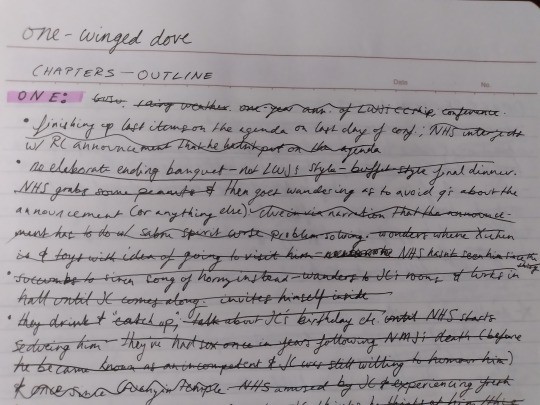
All the chapters in this fic have their own highlighter colour, so when I started trying to make sense of my initial brainstorm notes I just went through and highlighted stuff in the colour of the chapter it would make the most sense for, and then transcribed things more-or-less in chronological order into the relevant chapter outline. I later ended up rewriting all the chapter outlines AGAIN to refine them and divide them internally by the individual scenes, which makes them a lot more legible and less wall-of-text-y. They look like this now, with about four sheets per chapter:
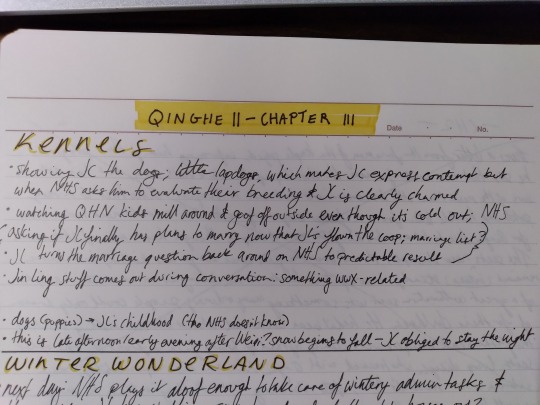
Because this fic is on the longer side, I have some pages that are just for keeping track of other story elements, like this, where I refer back to whatever the fuck the “themes” are supposed to be whenever I forget what this fic is about:
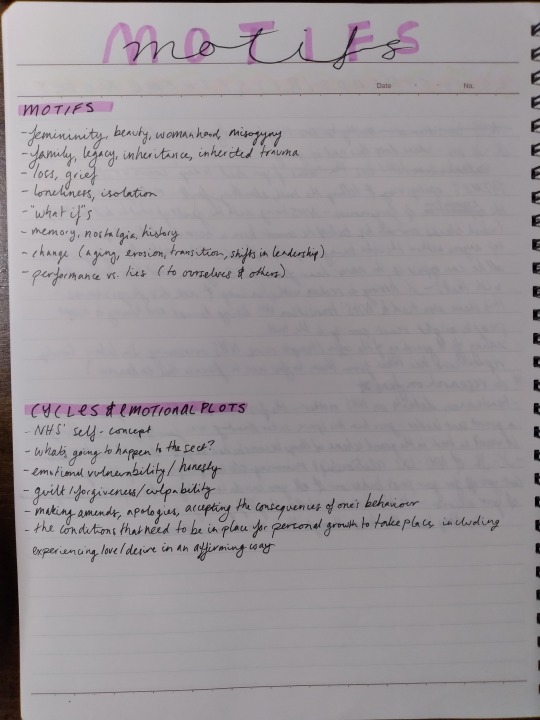
It’s all about the visionboarding... Anyway, that’s most of what I have to offer, since most of these two notebooks is Forbidden Content.
With regards to brands/supplies, I really like this Kokuyo Campus Wide notebook that I’m writing Sangcheng in, it’s pretty perfect for me. I also like the B5 Muji twin rings, but those only come in 30 sheets, so I wouldn’t use it for anything above a ~20k project. The B5 Maruman Spiral Note 6.5mm ruled/80 sheet is another good one, though I wish it was twin ring instead of spiral. As you can tell, I like Japanese stationery brands because it’s easier to find decent paper quality and minimalist design without shelling out $$ than it is with American/European brands, at least IME. I like Rollbahns too. But honestly, I can usually find pretty serviceable random notebooks that aren’t brand-name from Asian dollar stores; it’s really not something where you need to shell out tons of money.
29 notes
·
View notes